Content
Finite Element Analysis
One Dimensional Linear Element: in 2D Frame
Element
Shape Function or Interpolation Function
The Material Law or Constitutive Equations
The Element Stiffness Matrix
Force Equilibrium Approach
Minimum Total Potential Energy Approach
One Dimensional Linear Element: Example in 2D Frame
Element-wise Force-Displacement Equation
Element 1
Element 2
Element 3
Node-Wise Force-Displacement Equation
node 1
node 2
node 3
Global Force-Displacement Equation
Boundary Conditions and External Loads
Global Conditionalized Force-Displacement Equation
Force-Displacement Equation Solving
Finite Element Analysis
One dimensional linear element can be used to analysis structural pin jointed problems.
One Dimensional Linear Element: in 2D Frame
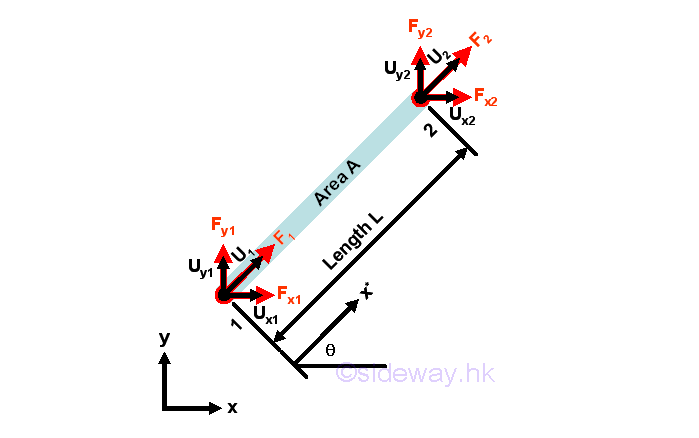
Element
In an 2D environment, a typical bar element of length L and cross-sectional area A is assumed to be oriented at an angle θ anticlockwise from x-axis. The forces acting upon the bar element, which can be expressed as an element vector, can be decomposited such that forces between each element can react to each other.
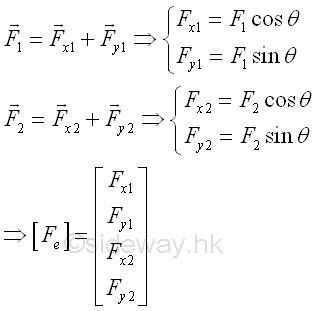
The displacements of the nodes of the bar element, which can be expressed as an element vector, can be decomposited and expressed in terms of decomposited elements such that displacements due to the bar element can be connected with other elements.
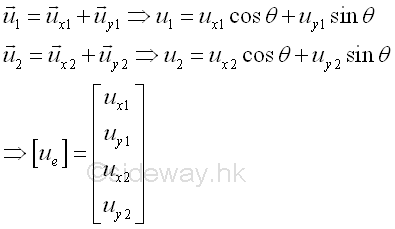
Shape Function or Interpolation Function
For a two-node linear element, the linear displacement function can be assumed to be a linear function of x* along the axial direction of the element That is

Similar to other boundary problems, this trial displacement function for the bar must satisfy the boundary displacement conditions at two nodes. That is

The displacement is therefore equal to
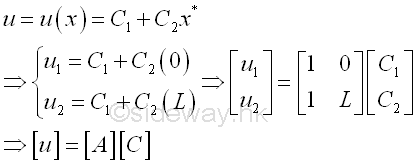
where [u] is the displacement vector of the element, [A] is a 'coordinate matrix', and [C] is the constant vector.
The constant matrix is therefore equal to
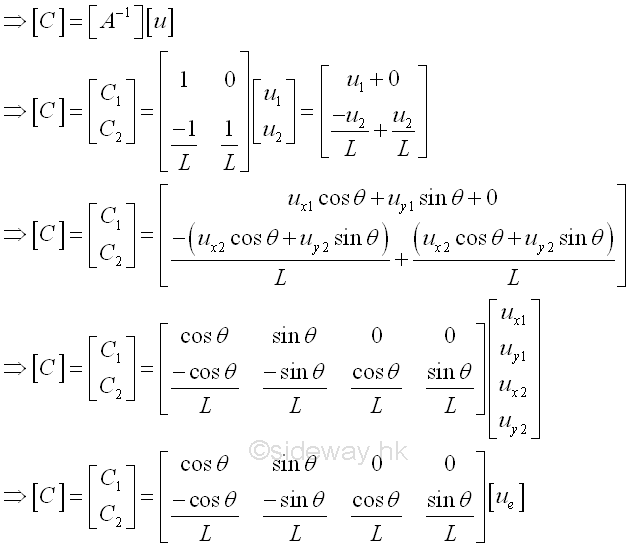
The displacement function and shape function are therefore equal to
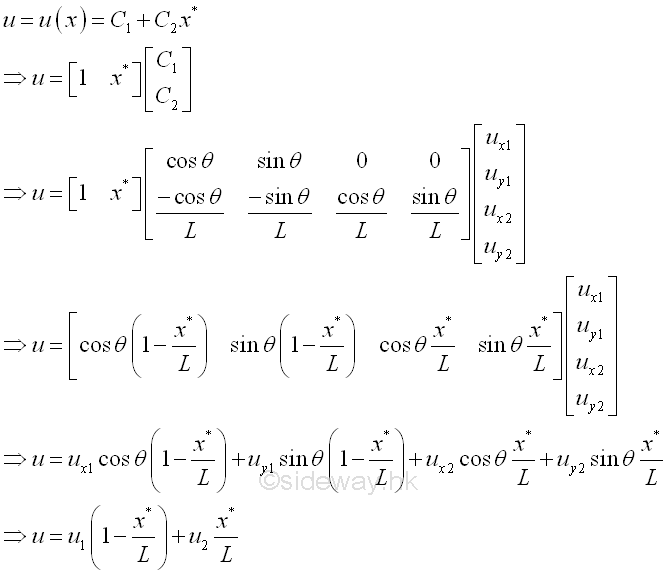
The Material Law or Constitutive Equations
Once the choice of shape functions is fixed, the type of the finite element is also determined. The finite element should also follow the law of material, that is the stress-strain relationships.
The strain in a bar element is given by
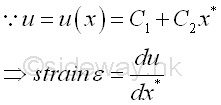
The strain of the element is therefore equal to
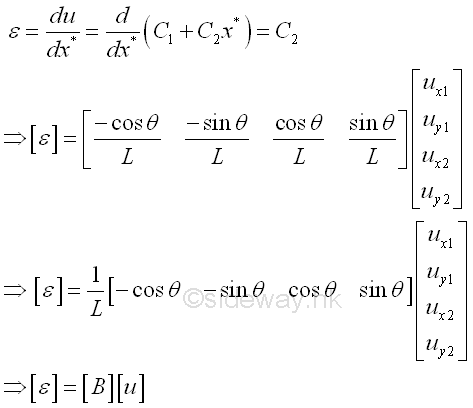
Where [B] is the strain displacement dimension matrix.
Since the bar element is under uniaxial load, the stress in a bar element is given by
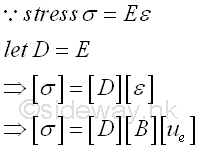
Where [D] is the material property or stress-strain matrix and is equal to the Young's modulus E for a uniaxial load. The stress is then expressed in terms of displacement also.
The Element Stiffness Matrix
Force Equilibrium Approach
Since the element is in equilibrium, the resultant force acting upon the element should be equal to zero. or forces act on the element is equal and opposite. Imply
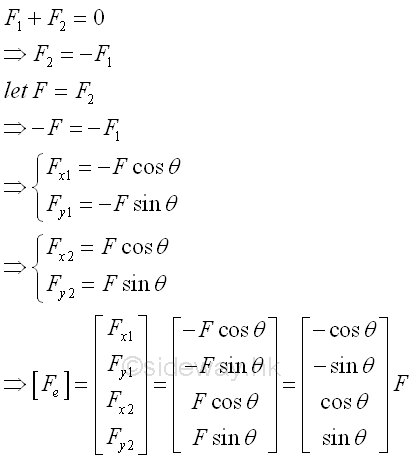
The element force vector can also be expressed in terms of the strain displacement dimension matrix [B], imply

Since the element is under an uniaxial load F, the stress in the element is equal to,

Therefore the element force vector can further be expressed in terms of displacement,
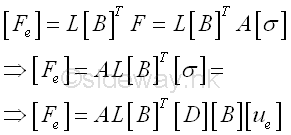
Therefore the element force vector can be expressed in form of stiffness times displacement,
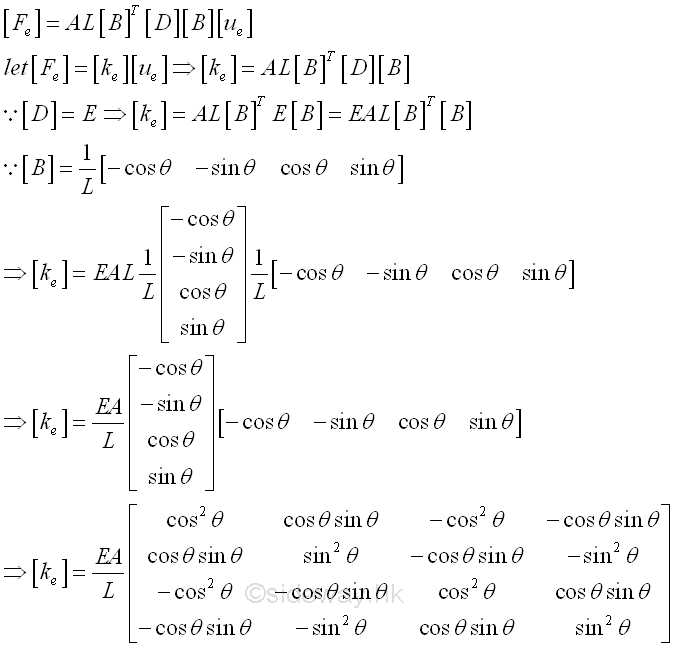
and the element stiffness matrix is a symmetric matrix.
Minimum Total Potential Energy Approach
By neglecting the body weight of the bar, the total potential enegy of the element is,
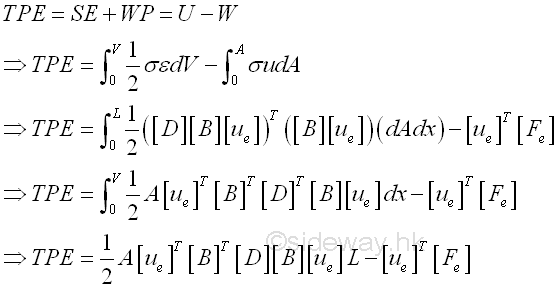
By the principle of minimum total potential energy, the differential of total potential energy (TPE) with respect to the displacement [Ue] must be zero, imply,
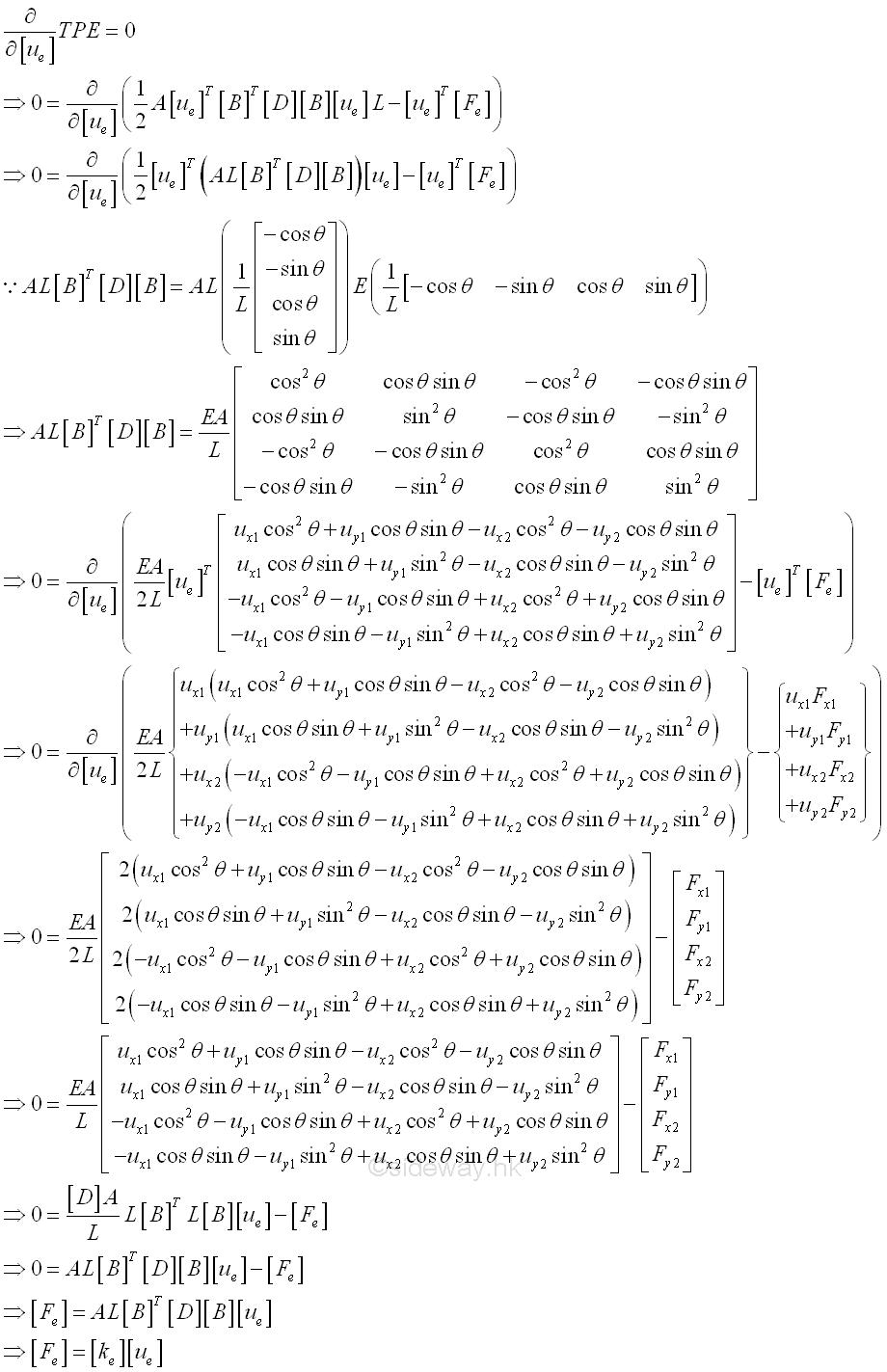
One Dimensional Linear Element: Example in 2D Frame
Consider a simple system with 3 elements of same material of Young's modulus E, length L and area A. Three elements are connected by hinges. Three elements are arranged in an equilateral triangle shape, with one end of element 1 is fixed to a wall and the other end of element 1 is supported by a roller, while there is an applied load F applied to the top hinge of the triangular structure.
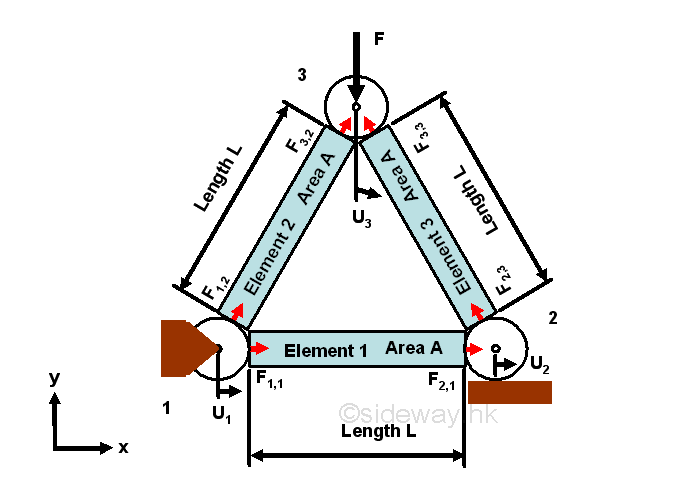
Element-wise Force-Displacement Equation
Element-wise Force-Displacement Equations for each element of the system can be constructed accordingly. Besides the length, cross-sectional area, and material property of each element, the orientation of the element is another important property of the element. For consistency, positive angle are used to orient the element at an angle θ anticlockwise from x-axis.

Element 1
For element 1, that is from node 1 to node 2, angle of orientation is 0 degree, length=L, area=A, Young's modulus=E, imply
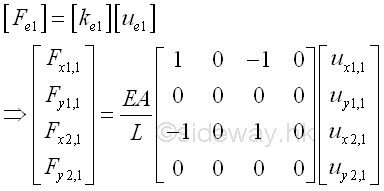
Element 2
For element 2, that is from node 1 to node 3, angle of orientation is 60 degree, length=L, area=A, Young's modulus=E, imply
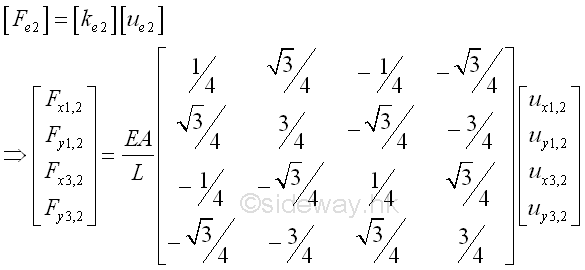
Element 3
For element 3, that is from node 2 to node 3, angle of orientation is 120 degree, length=L, area=A, Young's modulus=E, imply
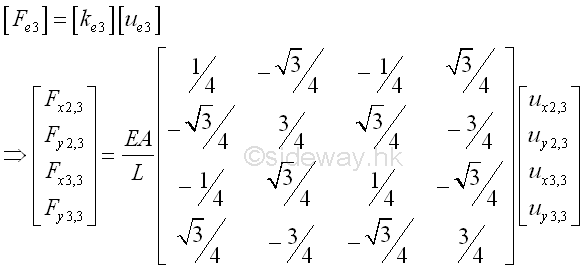
Node-Wise Force-Displacement Equation
For both the force equilibrium approach or the minimum potential energy approach, all element-wise force-displacement equations are in equilibrium. Since the displacement of any node in the system is same for every element attached to the node, the element-wise displacements of nodes are the same and with common displacement for every element connected. However, the considered element-wise force is not common force for every element connected to the node, and the forces for each element, in general, are usually difference in magnitude and direction. All element forces at a particular node are used to create the corresponding work potential for all element connected to the node, therefore the sum of all element forces are equal to induced forces due to the displacements of all elements connect to the node.

node 1
Two elements, 1 and 2, are connected at node 1. The sum of element forces at node 1 is equal to the sum of induced forces due to the displacements of all elements, 1 and 2, connect to the node 1.

node 2
Two elements, 1 and 3, are connected at node 2. The sum of element forces at node 2 is equal to the sum of induced forces due to the displacements of all elements, 1 and 3, connect to the node 2.
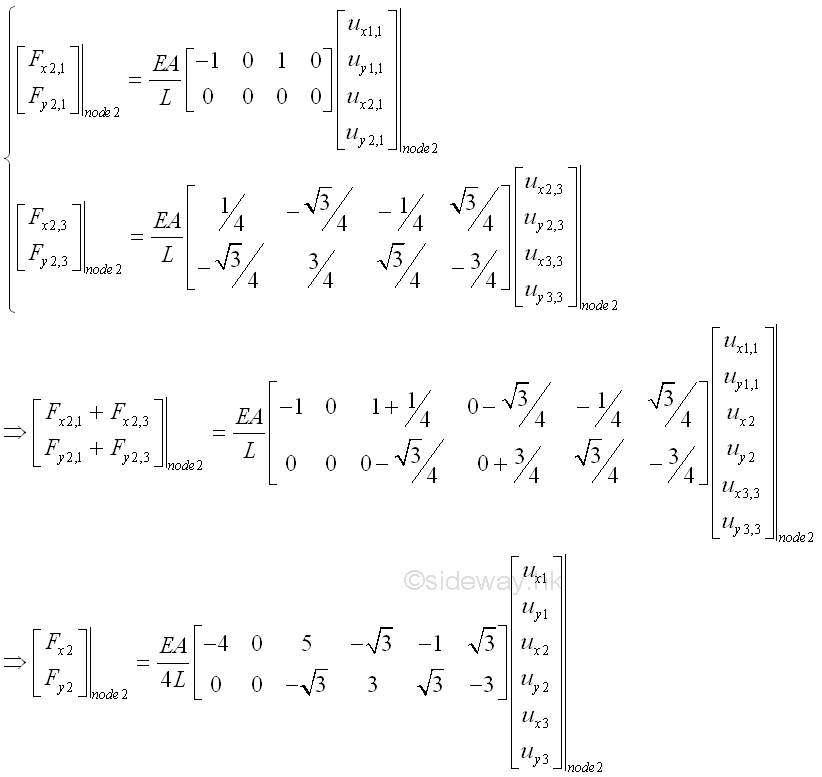
node 3
Two elements, 2 and 3, are connected at node 3. The sum of element forces at node 3 is equal to the sum of induced forces due to the displacements of all elements, 2 and 3, connect to the node 3.
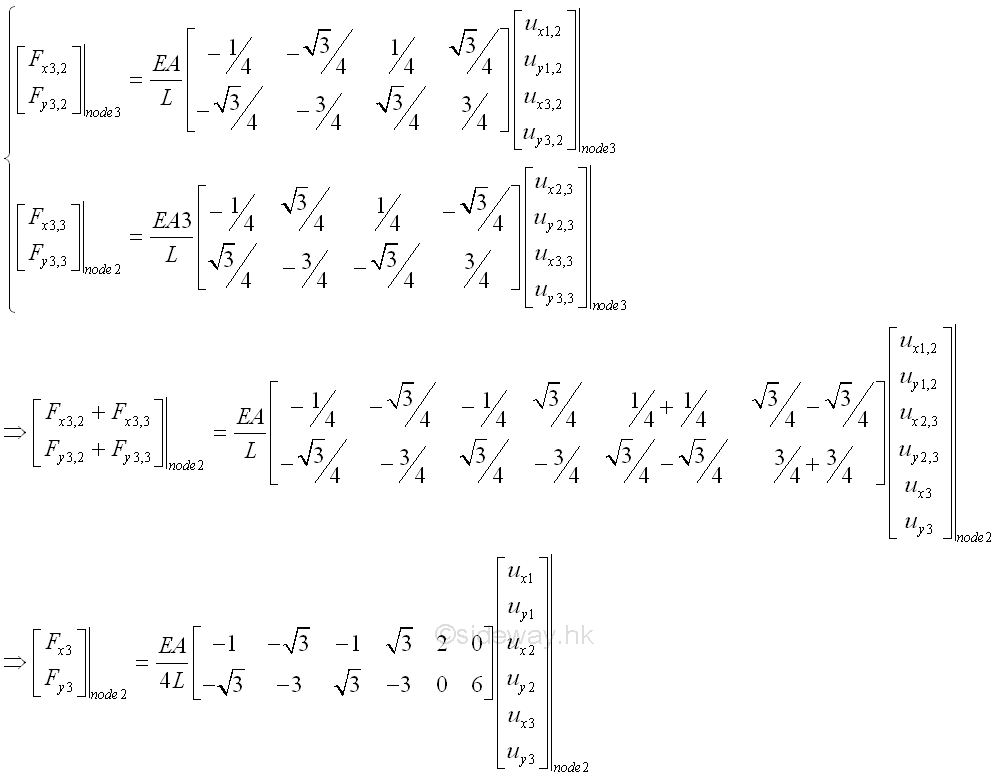
Global Force-Displacement Equation
All element forces can be assembled as a global system of equations in form of global matrices which contains all the nodes.

That is 2*3 element forces, 2*3 displacements at 3 nodes, and stiffness matrix is (2*3) by (2*3). imply
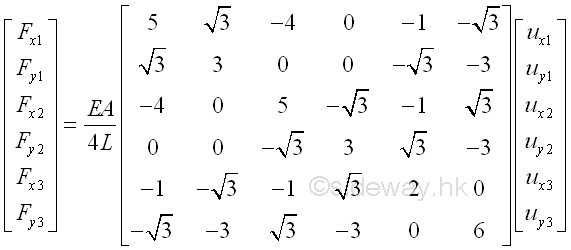
and the global stiffness matrix is a symmetric matrix.
Boundary Conditions and External Loads
Since the system of elements is in equilibrium, both forces and displacement at node should be in equilibrium. In other words, The displacements of nodes in the global force-displacement equations should be same as the allowable boundary conditions, and the element forces exerted on nodes should be equal to the external load acted upon the nodes accordingly. That is,
-
Fixed hinge at node 1. Fixed or no displacement on both x and y axes are allowed.
Imply ux1=uy1=0
-
Horizontal sliding hinge at node 2. No download movement or no displacement on y axis is allowed at node 2 in this case.
Imply uy2=0
-
Free or displacements on both x and y axes are allowed at node 3.
-
Only reactions due to fixed hinge at node1.
Imply Fx1=Rx1; Fy1=Ry1.
-
Only vertical reaction along y axis due to horizontal sliding hinge at node 2.
Imply Fx2=0; Fy2=Ry2.
-
Only external downward force F and no reaction due to free at node 3.
Imply Fx3=0; Fy3=-F.
Global Conditionalized Force-Displacement Equation
Substitute all boundary conditions and external loads into the global force-displacement equation. That is
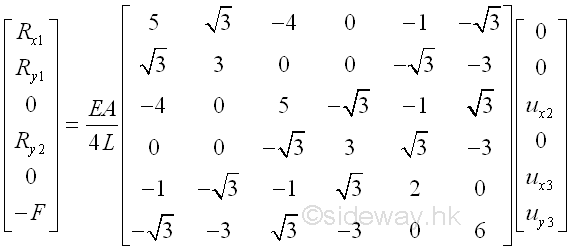
Force-Displacement Equation Solving
There are 6 force-displacement equations and 6 unknowns, therefore the global force-displacement equation can be solved. Since the most interested unknown variables are displacements, the global force-displacement equation can be divided into two parts. Force-displacement equations with unknown displacement variables and force-displacement equations with unknown reaction variables.
For force-displacement equations with unknown reaction variables which also depending on unknown displacement variables.
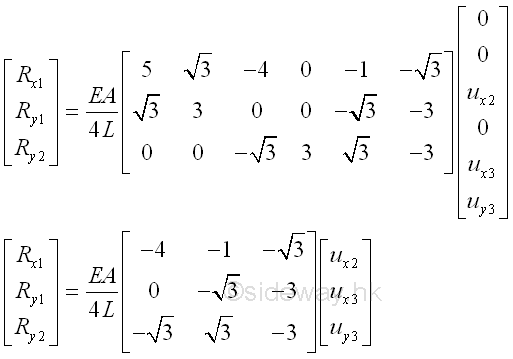
For force-displacement equations with unknown displacement variables
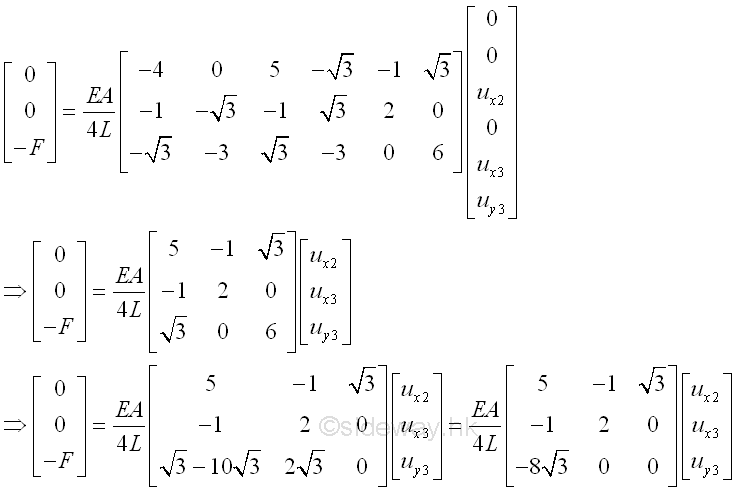
Unknown displacement variables are therefore equal to
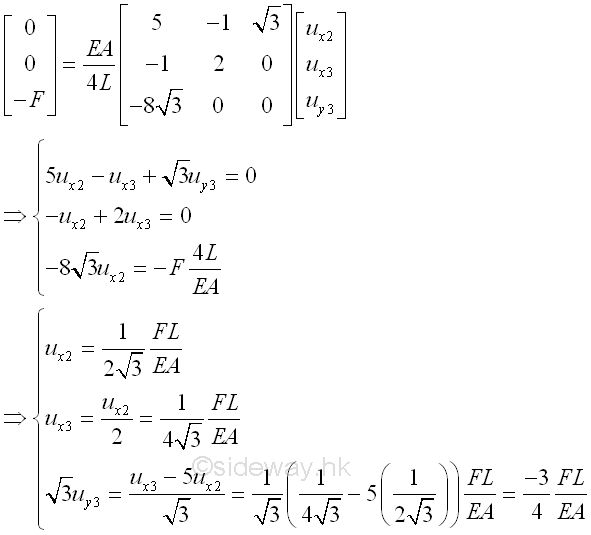
Unknown reaction variables are therefore equal to
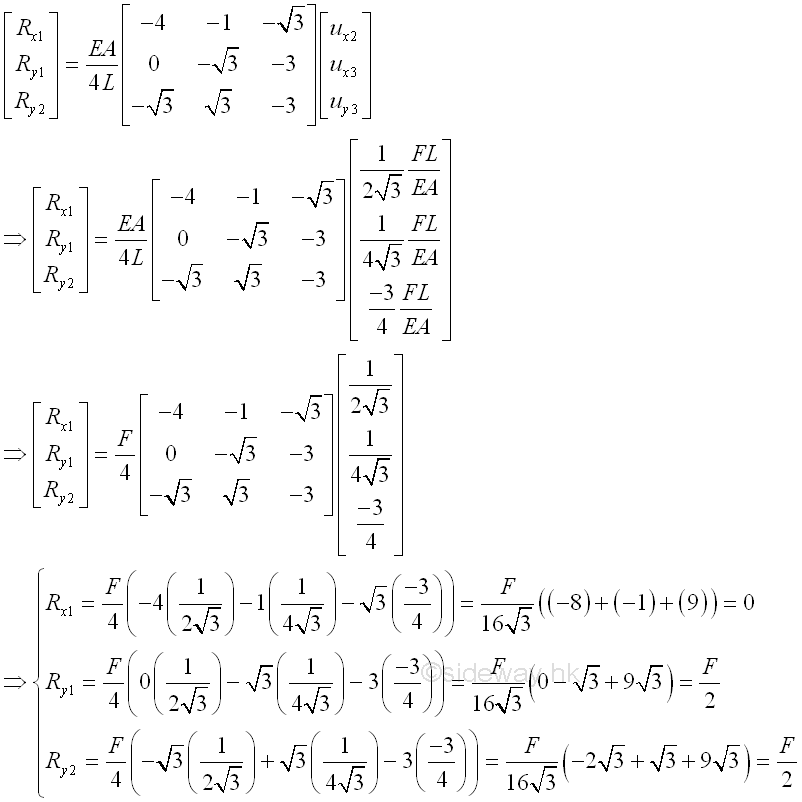
.
©sideway
ID: 140600017 Last Updated: 7/4/2014 Revision: 1 Ref:
References
- Paulo Ribenboim, 2000, My Numbers, My Friends: Popular Lectures on Number Theory
- Kenneth H. Rosen, 2012, Discrete Mathematics and Its_Applications
Latest Updated Links
- Travel Singapore Sight Mandai(last updated On 12/8/2025)
- Travel Singapore Sight Bird Paradise(last updated On 12/7/2025)
- Travel Singapore Sight(last updated On 12/6/2025)
- Travel Singapore Rail Network(last updated On 12/5/2025)
- Travel Singapore Things to Know(last updated On 12/4/2025)
- Travel Singapore(last updated On 12/3/2025)
- Legrand Galion(last updated On 12/2/2025)
- Schneider Electric AvatarOn(last updated On 12/1/2025)
- Alfalux(last updated On 11/30/2025)
- Novabell(last updated On 11/29/2025)
- TownGas NJW12RM1(last updated On 11/28/2025)

 Nu Html Checker
Nu Html Checker  53
53  na
na  na
na
Home 5
Business
Management
HBR 3
Information
Recreation
Hobbies 9
Culture
Chinese 1097
English 339
Travel 24
Reference 79
Hardware 54
Computer
Hardware 259
Software
Application 213
Digitization 37
Latex 52
Manim 205
KB 1
Numeric 19
Programming
Web 289
Unicode 504
HTML 66
CSS 65
SVG 46
ASP.NET 270
OS 431
DeskTop 7
Python 72
Knowledge
Mathematics
Formulas 8
Set 1
Logic 1
Algebra 84
Number Theory 206
Trigonometry 31
Geometry 34
Calculus 67
Engineering
Tables 8
Mechanical
Rigid Bodies
Statics 92
Dynamics 37
Fluid 5
Control
Acoustics 19
FiniteElement 2
Natural Sciences
Matter 1
Electric 27
Biology 1
